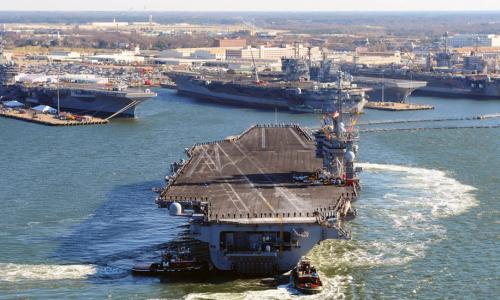Seas are projected to rise between 3.5 and 5.9 feet in the Portsmouth Naval Shipyard area by 2100.
During the second half of this century, in the absence of preventive measures, the installation can expect frequent and extensive tidal flooding, loss of currently utilized land, and substantial increases in the extent and severity of storm-driven flooding.
Base information
This location is one of 18 military installations featured in the 2016 report, "The US Military on the Front Lines of Rising Seas."New England has a long history of shipbuilding, and Portsmouth Naval Shipyward, which was established in 1800, has long been part of the region’s maritime culture.
Portsmouth NS is located on Seavey Island in York County, Maine, near the town of Kittery. The shipyard lies on the banks of the Piscataqua River, across from Portsmouth, New Hampshire.
It is a high-density industrial area housing 376 buildings; 116 are located in the Portsmouth NS Historic District and 50 are listed on the National Register of Historic Places.
Projected exposure to coastal flooding
The shipyard's exposure to coastal flooding is projected for the years 2050, 2070, and 2100 based on the National Climate Assessment’s midrange or “intermediate-high” sea level rise scenario (referred to here as “intermediate”) and a “highest” scenario based on a more rapid rate of increase.
Tidal flooding, land loss, and storm surge from hurricanes were all modeled. In this analysis, land inundated by at least one high tide each day is considered a loss. This is a conservative metric: in reality, far less frequent flooding would likely lead to land being considered unusable.
The results below outline potential future flooding scenarios for Portsmouth NS, assuming no new measures are taken to prevent or reduce flooding.
- Areas currently affected by occasional tidal flooding could flood daily. By 2050, low-lying areas in this region could experience between 80 and 190 floods per year—compared to fewer than a dozen currently—depending on the scenario. By 2070, in the highest scenario, floodprone areas throughout the region could on average experience flooding with each of the two daily high tides and be underwater more than 15 percent of the time.
- Flooding during extreme high tides will become more extensive. Today, Portsmouth NS itself sees little tidal flooding. By 2100, flooding during extreme tides could bisect the shipyard nearly a dozen times per year.
- Sea level rise threatens to claim currently utilized areas. How much of Portsmouth NS remains dry, usable land hinges on the trajectory of sea level rise through the end of the century and on the shipyard’s adaptation measures. In the highest scenario, more than a quarter of the shipyard’s land area, including places currently key to operations, would become part of the tidal zone
- Sea level rise exposes previously unaffected areas of Portsmouth NS to storm surge flooding. By 2100 in the highest scenario, sea level rise will increase the area exposed to flooding by Category 1 and 2 storms by roughly 20 percent. By this time, the area exposed to flooding from a Category 1 storm is greater than the area exposed to flooding by a Category 2 storm today.
- Sea level rise increases the exposure of Portsmouth NS to deeper, more severe flooding. By 2100 in the intermediate scenario, roughly 25 percent of the base would be exposed to flood depths of five feet or more by a Category 1 storm, compared to just 8 percent today.
Preparing for rising seas
The gap between the military’s current preparedness for sea level rise and the threats outlined here is large and growing.
In order to plan effectively for the long term, military decision makers with authority over Portsmouth NS need to understand how sea level rise may permanently alter the landscape of this coastal installation and where the threat of storm surge may become intolerable.
To take action, however, individual installations like Portsmouth NS will need more detailed analysis and resources to implement solutions.
Congress and the Department of Defense should, for example, support the development and distribution of high-resolution hurricane and coastal flooding models; adequately fund data monitoring systems such as our nation’s tide gauge network; allocate human, financial, and data resources to detailed mapping and planning efforts at military installations; and, as adaptive measures are identified, allocate resources for these projects, many of which will stretch over decades.
Our defense leadership has a special responsibility to protect the sites that hundreds of thousands of Americans depend on for their livelihoods and millions depend on for national security.
Additional maps and resources
This analysis modeled exposure to coastal flooding for four different points in time (2012, 2050, 2070, and 2100) and two different sea level rise scenarios.
For each time horizon and scenario, we analyzed storm surge from Category 1 through 5 hurricanes, the extent and frequency of flooding from extra-high tides, and inundation from ordinary high tides.
Detailed maps for each scenario at Portsmouth NS are available via Dropbox.
For more, please see the methodology for this analysis.




